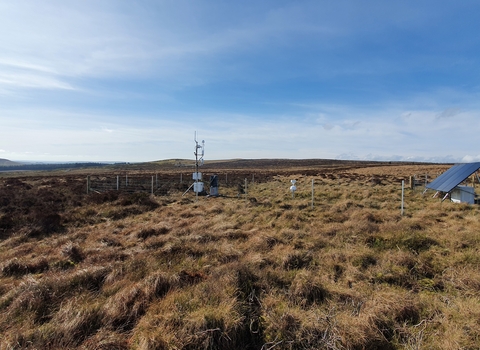“From a climate perspective, [peatlands] are the most essential terrestrial ecosystem.”
Tim Christophersen, Senior Program Officer, Forests and Climate, United Nations Environment Programme
Global peatlands
The accumulation and long-term storage of carbon as peat sets peatlands apart from other ecosystems and means they can play a key role in climate regulation. Known peatlands cover only about 3-4% of the globe but represent the largest carbon stock of the entire terrestrial biosphere1, with one third of the world’s soil carbon (c. 450,000 - 650,000 million tonnes) stored in peatlands around the world2,3. By capturing and storing carbon over millennia, peatlands have contributed to climate cooling by ~0.6°C during the Holocene (last 11,700 years)4. In their natural state, peatlands are remarkably resilient ecosystems with the ability to adapt to shifts in climate.
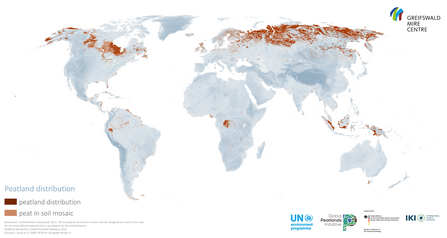
Estimated distribution of global peatlands. Source: Global Peatlands Assessment: The State of the World’s Peatlands | UNEP - UN Environment Programme.
Healthy peatlands generally capture more carbon than they release due to their waterlogged nature and this carbon storage is evidenced by the layers of peat soil that form slowly over time. When damaged, these peatlands can act as a significant greenhouse gas source. Drainage or damage to the surface of the peatland (e.g. through fire) exposes the upper layers of the peat to oxygen, which speeds up decomposition and carbon is rapidly lost into the atmosphere as CO2. Carbon is lost from the peat stores through water too as dissolved organic carbon and particles of peat soil wash away into watercourses.
An estimated 12% of global peatlands are degraded, emitting 1,940 million tonnes of carbon dioxide equivalents (CO2e) per year (excluding emissions from fires), equal to ~4% of total global anthropogenic GHG emissions3. Predictions state that if this rate of emissions from degraded peatlands were to continue until 2100, they will consume 41% of the remaining greenhouse gas emission budget to keep global warming below +1.5°C3.
See also the IUCN Peatlands and Climate Change Issues Brief (2021).
UK peatlands
UK peatland emissions status
Only around 22% of UK peatlands are currently in a near-natural or rewetted state, with near-natural bogs being close to climate neutral and near-natural fens acting as a small sink of greenhouse gases by sequestering 0.36 tonnes of CO2 equivalent per hectare every year6.
However, much of the UK’s peatland is no longer sequestering and storing carbon due to unsustainable land management practices. An estimated 80% of UK peatlands are degraded and have become a significant net source of greenhouse gases, emitting 29.8 million tonnes of CO2e each year3– equivalent to around 5% of the UK’s net greenhouse gas emissions in 20227.
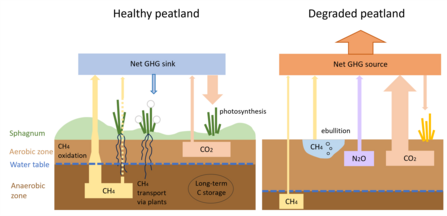
Greenhouse gas exchange between peat and the atmosphere on a healthy peatland compared to a degraded peatland. Credit IUCN UK Peatland Programme
A significant proportion of emissions from degraded peatlands comes from agricultural use (e.g. cropland, intensive grassland) of peat soils. Although only 13% of UK peatland area is used for lowland agriculture, this land use type contributes 44% of total peatland emissions7. Land use emissions from upland peat soils are also significant due to their extensive nature.
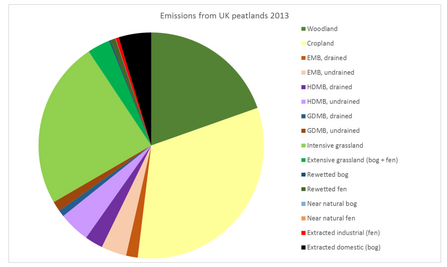
Contribution of individual ‘Tier 2’ peat condition categories to total UK emissions in 2013. EMB = Eroded modified bog, HDMB = Heather-dominated modified bog, GDMB = Grass-dominated modified bog. Source: Evans et al. (2014).
Restoration - recovering the balance
Peatlands represent an opportunity for helping to reverse the twin threats of the nature and climate emergencies. Whilst historic damage has resulted in significant peatland habitat and biodiversity loss, coupled with current high emissions, we do know how to reverse this damage on our remaining peatlands.
Preventing further damage, adaptive management and restoration of natural ecosystem function all have an important role to play in climate regulation within the UK. Peatland function can be repaired through restoration, which aims to return wetland conditions by restoring hydrology: such rewetting is recognised under international climate change agreements as one of the permitted activities for reducing greenhouse gas emissions. Adopting paludiculture – a wetter way of farming with raised water tables - provides the opportunity to reduce emissions from drained peatlands under intensive use whilst maintaining farming livelihoods.
General values for peatland emissions under different land uses have been agreed by the International Panel on Climate Change (IPCC), enabling countries to include emissions from damaged peatlands and savings from restored areas within national greenhouse gas accounting8. The Sixth Carbon Budget compiled by the Climate Change Committee (CCC) introduces a Balanced Pathway for the UK to reach net zero. The Balanced Pathway sets out that in England around 40,000 ha of degraded peat should be placed under restoration management, with a further 10,000 ha sustainably managed, during the period 2020 – 20249. The restoration of peatlands is currently significantly off track, but the goal remains: for example, in the longer term, the Balanced Pathway requires all upland peat to be restored by 2045 to help UK reach net zero10.
Methane emissions from peatlands
Whilst the waterlogged conditions of healthy peatlands help to capture and store carbon, these environments can also be a source of methane. Methane is produced as organic matter is broken down by bacteria in anaerobic conditions. This can cause concern, as rewetting of degraded peatlands often leads to increased methane emissions. Methane is also more potent at trapping heat in the atmosphere than CO2. However, the atmospheric lifetime of methane is much shorter (approximately 7-12 years) compared to CO2 (up to hundreds of years). This means that a dynamic equilibrium is eventually established, as the same amount of methane disappears from the atmosphere as is added by a healthy peatland. Methane emissions from healthy peatlands are natural, and do not contribute further to climatic warming over the long term.
In terms of the net climate effect, it is vital to consider the overall greenhouse gas balance of peatlands. In the UK, the combined methane emissions from near-natural fens and bogs are offset by the combined carbon uptake of these ecosystems. Whilst rewetted peatlands in the UK are still small overall greenhouse gas sources, the average greenhouse gas emissions from rewetted peatlands are 88% lower compared to degraded peatlands6.
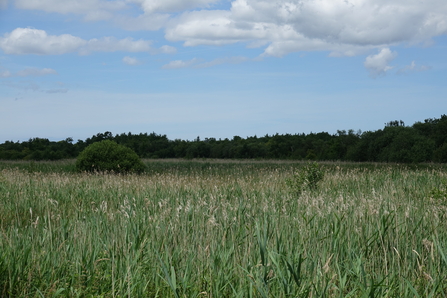
The Broads Fenland: a lowland fen in England. Credit Emma Hinchliffe
It is therefore possible to halt the loss of carbon from peatland through habitat restoration, and methane emissions are likely to be small in relation to the overall greenhouse gas benefits from restoring peatlands. Methane emissions from rewetted peatlands can be further limited by applying appropriate management techniques.
The Office for National Statistics has estimated that: “The net benefits, in terms of climate change emissions alone, of restoring 55% of [UK] peatlands to near natural condition are estimated to have a present value of approximately £45 billion to £51 billion11.”
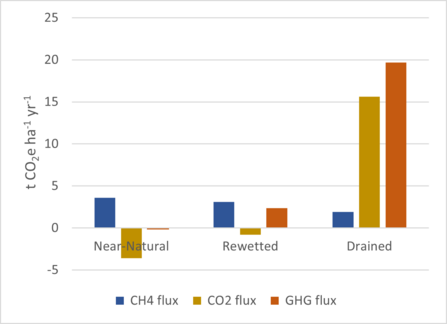
Average methane, carbon dioxide and overall greenhouse gas fluxes from UK peatlands in different conditions, based on Evans et al. (2022). GHG flux is a sum of CH4, CO2 and N2O fluxes. Positive values indicate a source and negative values a sink of gases. Note that the GHG flux for near-natural peatlands is -0.02 tCO2 ha-1 yr-1, representing a very small overall sink.
Measuring emissions from peatlands
Greenhouse gases such as CO2 and methane emitted from peatlands can be directly measured using chambers or eddy covariance flux towers. Static chambers placed on the surface of the peatland capture gases emitted by the peat, and the concentrations of these gases can be quantified and analysed. The chamber method allows the measurement of gases emitted over very small areas, enabling microhabitats to be sampled across the peatland. Eddy covariance flux towers measure the vertical flux of gases between the surface and the atmosphere, capturing the fluxes over a landscape scale as part of longer-term monitoring.
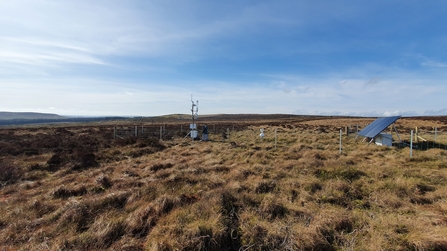
A flux tower set up by CEH and funded by DAERA monitoring carbon fluxes on CAFRE Hill Farm. Credit Hollie Cooper/CEH.
A network of flux towers – such as the one on CAFRE Hill Farm site on the image above – have been set up across the UK to examine the exchange of CO2 and CH4 over peatlands. 21 towers have been set up across England, Wales, and Northern Ireland (managed by the UK Centre for Ecology and Hydrology) and nine in Scotland (managed by the James Hutton Institute)5. The emissions data is used by researchers to determine how emissions vary across different types of peatlands, what controls the exchange of gases, how effective restoration techniques are in reducing emissions and what the contribution of peatlands is to achieving net zero in the UK5.
Funding the change
The UK Peatland Strategy has set a target of 2 million hectares of peatland in good condition, under restoration or being sustainably managed by 2040. To reach this goal, conservation, restoration and sustainable management of our peatlands is vital, supported by the funding needed to achieve this. Public and private finance are required, including green finance initiatives such as the Peatland Code. The Peatland Code is a voluntary standard for UK peatland projects wishing to market the climate benefit of restoration and enables landowners to generate income from peatland restoration through the sale of carbon credits based on emissions reductions. The Peatland Code works on the basis that during restoration, carbon savings are made through rapid emissions reductions, and these can be quantified and valued. The Code is aligned with the UK greenhouse gas inventory and uses this government-backed science to quantify restoration benefits.
References
-
Temmink RJM, Lamers LPM, Angelini C, Bouma, TJ, Fritz C, van de Koppel J. et al. Recovering wetland biogeomorphic feedbacks to restore the world’s biotic carbon hotspots. Science. 2022;376(6593). https://doi.org/10.1126/science.abn1479
-
Food and Agriculture Organisation. Peatlands Mapping and Monitoring: Recommendations and Technical Overview. 2020. http://dx.doi.org/10.4060/ca8200en
-
UNEP. Global Peatlands Assessment – The State of the World’s Peatlands: Evidence for action toward the conservation, restoration, and sustainable management of peatlands. Main Report. Global Peatlands Initiative. 2022.
-
Yu Z, Beilman DW, Frolking S, MacDonald GM, Roulet NT, Camill P. et al. Peatlands and their role in the global carbon cycle. Eos, Transactions American Geophysical Union 2011;92(12), 97–98. https://doi.org/10.1029/2011EO120001
-
Coyle M, Morrison R, Artz R, Johnson-Marshall A, Cash J and the UK GHG FluxNet. UK GHG Flux Network – Peatlands. EGU General Assembly 2023. Vienna, Austria, 24–28 Apr 2023, EGU23-14987. https://doi.org/10.5194/egusphere-egu23-14987
-
Evans C, Artz R, Burden A, et al. Aligning the Peatland Code with the UK Peatland Inventory. Report to Defra and the IUCN Peatland Programme. 2022.
-
Department for Energy Security & Net Zero. 2022 UK Greenhouse Gas Emissions, Final Figures. 2024. 2020 UK Greenhouse Gas Emissions, Final Figures (publishing.service.gov.uk)
-
IPCC. Agriculture, Forestry and Other Land Use. In IPCC Guidelines for National Greenhouse Gas Inventories (Vol.4). 2006.
-
Climate Change Committee. Progress in adapting to climate change. 2023 Report to Parliament. March 2023 Progress in adapting to climate change 2023 Report to Parliament (theccc.org.uk)
-
Climate Change Committee. Progress in reducing emissions. 2023 Report to Parliament. Progress-in-reducing-UK-emissions-2023-Report-to-Parliament.pdf
-
Office for National Statistics. UK natural capital: peatlands. 2019. UK natural capital - Office for National Statistics (ons.gov.uk)

